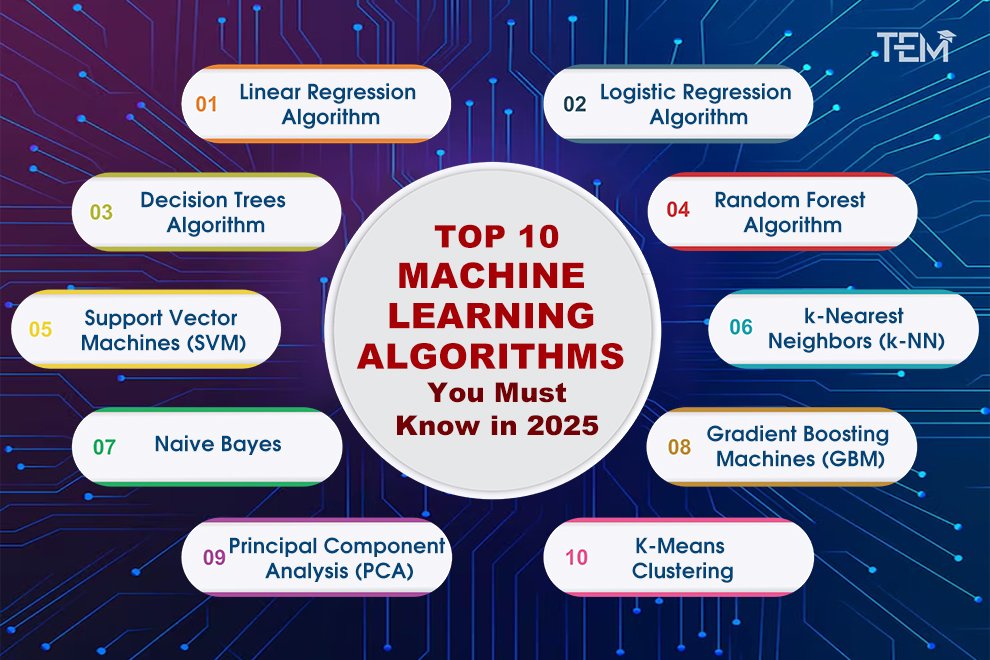Did you know that machine learning is the most in-demand job in 2024? With companies across industries using AI for everything from fraud detection to customer insights, the demand for skilled machine learning professionals is increasing rapidly. In this case, over 30% of tech students are now choosing machine learning as a career path, recognizing the incredible opportunities it offers. If you’re curious about this field, mastering the right algorithms is key. In this blog, we’ll walk you through the top 10 machine learning algorithms you need to know to stay ahead in the game. Learn all the algorithms given below and crack your first job.
10 Top Machine Learning Algorithms You Need to Know
1. Linear Regression Algorithm
- Algorithm Type: Supervised Learning (Regression)
Tools used:
| Programming Languages | Python and R |
| Libraries and Frameworks | Python, libraries like NumPy, pandas, and sci-kit-learn |
| Statistical Software | SPSS, SAS, and Stata |
What does it do?
A linear regression method is among the most often used forms of machine learning algorithms. One type of learning method used to forecast the relationship between two variables is the linear regression technique.
Now, this is done by assuming a linear relationship between a dependent variable or one or more independent variables. In return, logistic regression models the probability of a binary outcome using a logistic function. Further, it outputs probabilities and classifies instances by setting a threshold (usually 0.5).
Lastly, the algorithm is used to resolve binary classification problems and predictive analysis. Moreover, the real-world use cases include predicting the stock market and forecasting future sales trends, email spam detection, disease diagnosis, and credit scoring.
Key Points:
- Above all, it is simple and easy to implement.
- Assumes a linear relationship between the input features and the log odds of the outcome.
- Possibly, it works well for binary classification problems.
2. Logistic Regression Algorithm
- Algorithm Type: Supervised Learning (Classification)
Tools used:
| Libraries and Frameworks | Python, sci-kit-learn, statsmodels, TensorFlow |
| Development Environments | Jupyter Notebook, RStudio, and PyCharm |
| Data Visualization Tools | Matplotlib, Seaborn in Python, and ggplot2 in R |
What does it do?
Logistic regression is one of the machine learning algorithms that predicts the probability of an outcome by analyzing the relationship between a set of independent variables. In any case, this algorithm predicts the probability that an instance belongs to a given category or group.
In addition, this algorithm analyzes the relationship between multiple independent variables and classifies them into binary classes 0 and 1. Also, in case the value of less than 0.5 denotes 0, and more than 0 denotes 1. Hence, these numbers represent 0 and 1, as well as true or false and yes or no.
For example, it could process an email and sort it into a spam category. Indeed it can also be used in other tasks. Sometimes, including image recognition, fraud detection, and credit scoring. Further, Image recognition, fraud detection, credit scoring, and prediction diagnosis too are examples of practical use cases.
Key Points:
- Highly accurate and efficient.
- Enhances interpretability and data visualization
- Performs well with high-dimensional data.
3. Decision Trees Algorithm
- Algorithm Type: Supervised Learning (Classification/Regression)
Tools used:
| Integrated Development Environments | Jupyter Notebook for Python and RStudio for R |
| Data Visualization Tools | Matplotlib and Seaborn in Python or ggplot2 in R |
| Statistical Software | IBM SPSS, SAS, and RapidMiner |
What does it do?
Using a decision tree to classify data and predict outcomes, a decision tree method is a non-parametric supervised learning technique. Hence, the tree is a hierarchical structure consisting of a root node, branches, and leaf nodes, which function like a flow chart.
Therefore, developers use decision trees to complete classification and regression tasks. Essentially, these machine learning algorithms provide transparency over why data was placed into a particular category.
Additionally, it is used in predictive modeling, regression, and classification tasks. Subsequently, it often goes under predictions of customer behavior and price movements and to diagnose certain conditions too.
Key Points:
- Easy to interpret and visualize.
- Can handle both numerical and categorical data.
- Lastly, it is prone to overfitting without proper pruning.
4. Random Forest Algorithm
- Algorithm Type: Supervised Learning (Classification/Regression)
Tools used:
| Libraries and Frameworks | sci-kit-learn, randomForest, and ranger |
| Integrated Development Environments | Jupyter Notebook and RStudio |
| Evaluation Metrics and Validation Tools | Accuracy, precision, recall, F1 score |
What does it do?
A single result is generated by a random forest algorithm, which aggregates the output of several decision trees. Therefore, this method involves bagging, or training each tree on a random subset of training data.
Possibly, each tree produces its prediction, and then the average or majority prediction is used to make a more accurate prediction. Besides that, random forest machine learning algorithms are generally used to resolve classification and regression problems.
Furthermore, it is used to solve classification and regression problems. Consequently, it is applicable in risk monitoring, fraud detection, pricing, and recommendation engines too.
Key Points:
- Firstly, it reduces overfitting compared to individual decision trees.
- Handles large datasets with higher dimensionality.
- Equally requires more computational resources.
5. Support Vector Machines (SVM)
- Algorithm Type: Supervised Learning (Classification)
Tools used:
| Libraries and Frameworks | sci-kit-learn, TensorFlow, PyTorch, e1071 |
| Statistical Software | SPSS and SAS |
| Evaluation Metrics | Accuracy, precision, recall, F1 score, and ROC-AUC |
What does it do?
These machine learning algorithms called Support Vector Machine, or SVM, are used to resolve problems with regression, predictive modeling, and classification. Also, to divide data points that belong to various classes, the best decision border is found using the SVM algorithm.
Certainly, SVM is a tool that developers can use to predict classifications more accurately. As a result, it’s widely used in areas such as text classification, image classification, spam filtering, facial recognition, and anomaly detection tasks.
In addition, used to resolve binary classification, regression, and outlier detection problems. So, its applications include text and image classification, spam filtering, facial recognition, and anomaly detection tasks.
Key Points:
- Effectively it is in high-dimensional spaces.
- Also, it works well for both linear and non-linear classification using kernel tricks.
- Sensitivity to the choice of regularization parameter.
6. k-Nearest Neighbors (k-NN)
- Algorithm Type: Supervised Learning (Classification/Regression)
Tools used:
| Libraries and Frameworks | sci-kit-learn, NumPy, pandas |
| Data Visualization Tools | Matplotlib and Seaborn |
| Validation and Evaluation Metrics | Accuracy, precision, recall, and F1 score |
What does it do?
K-nearest neighbor is one of the unique machine learning algorithms that’s used in classification and predictive modeling. So, it calculates the distance between data points to find the nearest neighbors to a given data point before classifying it based on this information.
Moreover, KNN classifies data points based on how close they are to their neighbors. Although, similar data points should be found nearby, according to the theory. More precisely, it can be applied to data mining, intrusion detection, and pattern recognition jobs.
Besides that, it can be used for classification and regression problems. However, developers can use KNN for pattern recognition, data mining, and intrusion detection.
Key Points:
- Simple and intuitive.
- No complex training phase, making it an easy learner.
- Sensitive to the choice of the distance metric.
7. Naive Bayes
- Algorithm Type: Supervised Learning (Classification)
Tools used:
| Programming Languages | Python and R |
| Libraries and Frameworks | sci-kit-learn, pandas, NumPy, e1071 |
| Evaluation Metrics | accuracy, precision, recall, and F1-score |
What does it do?
Equally, these machine learning algorithms called Naive Bayes classifiers classify objects by applying the Bayes theorem. Also, its purpose is to estimate, given the presence of specific attributes or values, the likelihood that an instance would belong to a class.
Essentially, Naive Bayes uses Bayes’ theorem with the assumption of feature freedom to classify instances. Besides that, Bayes’ theorem assumes that a feature in a given class is unrelated to other features or factors.
Hence, this approach makes such types of machine learning algorithms a good option for building predictive models. Moreover, it’s also handy for classification tasks. Further, you’ll often see it in action in real-world scenarios like text classification, sentiment analysis, and spam filtering.
Key Points:
- Initially, it is considered a fast and efficient type of algorithm.
- Performs well with high-dimensional data.
- The assumption of feature independence might not hold in all cases.
8. Gradient Boosting Machines (GBM)
- Algorithm Type: Supervised Learning (Classification/Regression)
Tools used:
| Libraries and Frameworks | sci-kit-learn, XGBoost, LightGBM, and CatBoost |
| Integrated Development Environments | Jupyter Notebook and RStudio |
| Performance Evaluation Metrics | Accuracy, precision, recall, and F1 |
What does it do?
A gradient boosting algorithm is used to combine the predictions of multiple weak learning models iteratively, optimizing weights based on the previous model’s errors. Besides that, gradient-boosting machine learning algorithms provide a training approach where multiple weak learning models are combined.
Importantly, under this approach, the predictions of each model are taken and used to optimize weights based on errors of the previous models. Mostly, doing this increases the overall accuracy of the model’s output building more powerful models.
Plus, gradient boosting isn’t just unique. But it’s great for both classification and regression tasks. It’s especially effective when dealing with large, complex datasets, like those used in web search rankings, customer churn predictions, and insurance risk assessments. In any case, developers turn to gradient boosting to tackle various regression and classification problems.
Key Points:
- Highly accurate and efficient.
- Can handle different types of data.
- Prone to overfitting if not properly tuned.
9. Principal Component Analysis (PCA)
- Algorithm Type: Unsupervised Learning (Dimensionality Reduction)
Tools used:
| R Packages | stats, prcomp, and PCAtools |
| Visualization Tools | Matplotlib and Seaborn in Python, ggplot2 in R |
| Dimensionality Reduction Libraries | PCAtools in R |
What does it do?
Principal Component Analysis (PCA) acts as a powerful statistical technique for reducing the dimensionality of large datasets while preserving essential information. It is one of the most efficient machine learning algorithms.
On top of that, it transforms high-dimensional data into a lower-dimensional space by identifying the principal components that capture the maximum variance in the data. Also, this helps simplify data exploration and visualization while maintaining significant patterns and relationships among variables.
Furthermore, it can be used in neuroscience, finances, and image processing. Beyond these domains, PCA finds applications in marketing research, quality control, and public administration.
Key Points:
- Dimensionality Reduction in a data set
- Enhances interpretability and data visualization
- Certainly, pattern preservation is involved
10. K-Means Clustering
- Algorithm Type: Unsupervised Learning (Clustering)
Tools used:
| Python Libraries | scikit-learn, NumPy, and pandas |
| R Packages | stats, ggplot2 |
| Data Visualization Tools | Matplotlib and Seaborn |
What does it do?
K-means is an unsupervised algorithm designed to group similar data points to solve pattern recognition and clustering problems. To begin with, machine-learning algorithms calculate the distance between the data point and a centroid to assign it to a cluster.
In effect, the final goal is to minimize the total distances between each point and the cluster centroid by grouping data points with comparable properties together. On top of that, the application of k means can be made to complex projects like fraud detection and consumer segmentation, as well as predictive modeling.
Most importantly, it can be used for predictive modeling. In return, it’s commonly used for tasks like market customer segmentation and fraud detection, customer segmentation, market research, and image compression.
Key Points:
- In any case, it is a simple and efficient type of algorithm.
- Sensitive to the initial placement of centroids.
- Subsequently, it assumes clusters are spherical.
Conclusion
In the end, we hope as we move further into 2025, the importance of mastering these top 10 machine learning algorithms becomes increasingly evident. In any case, as you continue your journey in AI, these tools will be invaluable. Also, follow us on the below platforms for more insights and stay updated on the latest in machine learning algorithms.
Facebook: https://www.facebook.com/TheEducationMagazine
Linkedin: https://www.linkedin.com/company/14633191/admin/feed/posts/
Twitter: https://twitter.com/TheEducationMag










